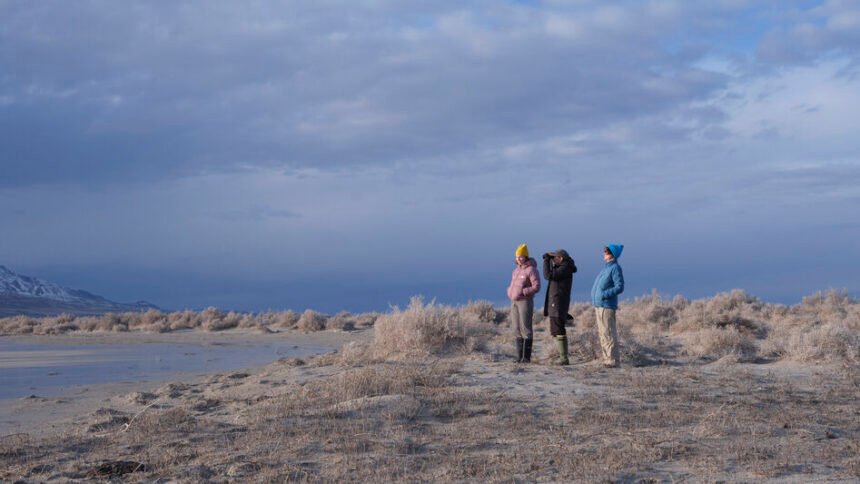SALT LAKE CITY, Utah — Drive west of this sprawling high desert city, past its newly built international airport, through a series of locked gates into the Audubon’s Gillmor Sanctuary and it’s like entering another world.
Or maybe better put, an other worldly landscape: the vast, and drying wetlands along the Great Salt Lake, the largest saline lake left in the western hemisphere, some fifty miles long and thirty wide.
“It’s quite an adventure to get out here,” says Carly Biedul, a wildlife biologist at nearby Westminster University. She’s part of a team of scientists who have been tracking the lake’s decline amid the West’s record megadrought made worse by climate change. They’ve been conducting weekly trips to various sampling and study sites for the last several years at the remote lake that only recently started making international headlines due to its sharp decline.
Even since its water levels peaked in the 1980s, the Great Salt Lake has always had this mysterious vibe. It’s shallow and boggy. It can stink, especially in the heat of summer.
But zero in right here at this private sanctuary – where steady water still flows in due to a complex web of agreements – and it soon becomes clear how alive this ecosystem can be and how hugely important of a stopover it is for migratory birds.
Despite recent moisture, the lake is still shrinking
2023 brought record snow to Utah, and a healthy spillover of runoff into the imperiled lake. Scientists warn the lake has already shrunk nearly in half from its historical average.
“It’s because of so many years of drought and climate change and water diversions, and we can’t keep going like that,” says Bonnie Baxter, director of the Great Salt Lake Institute.
But she says there’s still time to reverse its decline. The last two years has bought the state some time. Researchers here are already detecting sharp declines in shorebird populations such as burrowing owls and snowy plovers. As the lake and its wetlands dry, the brine shrimp the birds feed on are dying out.
“For these birds that queue into these saline habitats, there are fewer places for them to go,” says Heidi Hoven, a wetlands ecologist who helps manage the Gillmor. “All the saline lakes here in the West, and many in the world, are experiencing this loss of water and in essence that relates to a loss in habitat.”
There are plenty of culprits behind the lake drying up
Scientists say the West is believed to be as dry as it’s been in 1200 years. The megadrought made worse by climate change has been contributing to the Great Salt Lake’s decline. But agriculture usually bears the bulk of the blame. Upstream water diversions for expanding alfalfa farms and dairies has meant less and less flows into the lake. Utah’s population is also booming. Hoven says development is now running right up to the sanctuary.
“You can actually see it over your shoulder,” she gestures. “It’s this advancement of large, distribution warehouses that are within a mile from the sanctuary now where it used to be open land.”
A short, bumpy ride later along a rutted out dirt track, Hoven pulls to a stop at a favorite vista. The setting sun is casting an eerie orange glow over the distant mountains that ring the dry lake bed. It stretches for miles with just a few pools of water here or there.
It’s beautiful but also eerie, even for the trained eye of wildlife biologists like Biedul, who make weekly research trips to the lake.
“Otherworldly is a great word,” she says. “It’s crazy. We’re at Great Salt Lake right now but there’s no water. The other places where I go and sample there’s water there at least. But here we’re still at the lake and it’s dry.”
Hoven chimes in, solemnly.
“It’s just so shocking, and you know, it’s a shock to me every time I see it,” she says. “But to see someone view it for the first time. You can really see them taking it in. You never thought you could see this dryness.”
The state is being galvanized into action
But all this shock and alarm, the scientists say, may be good. It’s pressuring state leaders into action. Utah Governor Spencer Cox has pledged the lake won’t dry up on his watch. The state legislature has put upwards of a billion dollars lately into water conservation programs, most geared to farmers.
“For generations the lake was seen as kind of this dead thing that just happens to be there and will always be there,” Cox told NPR recently. “And now that people are realizing there’s a potential that it might not always be here, that’s gotten people’s attention in a positive way.”
Everything from lake effect snow for the lucrative ski industry, to mining, to air quality depends on the lake’s survival. Recent publicity around the crisis has raised public awareness but also started to bring more money which could lead to more comprehensive research that could inform everything from strategic action plans to save the lake to just understanding how the remaining migratory birds are coping.
Heidi Hoven, the wetlands ecologist, sees the shorebirds as a key indicator species.
“We have so much more to understand about what their needs are,” she says. “In these changing times, it’s really highlighting the need to understand these things quickly.”
The scientists say the last two winters may have bought Utah a little time, but no one in the West is counting on another good snow year next year.
Transcript :
SCOTT SIMON, HOST:
Trip now out to Utah’s Great Salt Lake, where water levels are up 3 feet after a couple of especially wet winters. That’s actually good news because the lake has been drying up fast. It is now about half of its historical size. NPR’s Kirk Siegler recently took a trip to a private wildlife sanctuary there, with scientists who’ve been warning about a looming ecological disaster.
KIRK SIEGLER, BYLINE: Just west of Salt Lake City and its newly built international airport, we drive through a series of locked gates, heading for the Audubon’s Gillmor Sanctuary.
(SOUNDBITE OF GATE LOCK OPENING)
SIEGLER: It’s like entering into another world – or maybe otherworldly – landscape, the vast wetlands along the Great Salt Lake, 50 miles long and 30 wide.
CARLY BIEDUL: Yeah, it’s quite an adventure to get out here.
SIEGLER: It’s always had this mysterious vibe. It’s shallow. It’s boggy. It stinks. But zero in right here, and you realize how alive it can be, how hugely important of a stopover it is for migratory birds.
(SOUNDBITE OF BIRDS SINGING)
SIEGLER: Sadly, sounds like these, archived by the University of Utah back in 2011, are becoming more and more rare out here. As the lake and its wetlands dry, the brine shrimp the birds feed on are dying. Heidi Hoven, a wetlands ecologist who helps manage the sanctuary, is leading our expedition.
HEIDI HOVEN: There’s less and less places for these birds that do queue in to these saline habitats. There’s fewer places for them to go.
SIEGLER: Hoven and her team are tracking a sharp decline, particularly in burrowing owls and snowy plovers, white-breasted with their tiny black beaks.
(SOUNDBITE OF BIRD SINGING)
SIEGLER: There are plenty of culprits behind the lake drying up. Farmers are diverting a lot of water upstream from here that used to flow into it. Utah’s population is also booming, and that development is running right up to us.
HOVEN: You can actually see it over your shoulder. We have – it’s this advancement of large distribution warehouses that are within a mile from the sanctuary now, when it used to be just open land.
SIEGLER: Back in her pickup, Hoven steers expertly through a series of huge, muddy puddles that look like they could swallow us.
(SOUNDBITE OF TRUCK DRIVING THROUGH MUD)
HOVEN: So there’s a little bit of road base left under all that.
SIEGLER: For the scientists, the mud is an encouraging sign. Utah is coming off two snowy winters.
HOVEN: So we can park here. This is a good get-out place.
SIEGLER: We stopped for a beat to take it all in, just shy of the lake bed. Bonnie Baxter, who runs the Great Salt Lake Institute at nearby Westminster University, chimes in.
BONNIE BAXTER: You know, I think we’ve bought ourselves a couple of years, and that’s great. But you look at this dry lake bed in front of you, and you can see, even after all of that snow from last year and a decent year this year, we’re still struggling.
SIEGLER: A short, bumpy ride later, we reached the actual shore, if you could call it that. The setting sun is casting an eerie orange glow over the distant mountains surrounding us on all sides. We feel tiny.
(SOUNDBITE OF TRUCK DOOR CLOSING)
SIEGLER: The dried lake bed stretches out for miles. It’s beautiful, but it’s eerie, even for the trained eye of wildlife biologist Carly Biedul.
BIEDUL: Otherworldly is a great word. It is – well, it’s crazy. We’re at Great Salt Lake right now, but there’s no water.
BAXTER: Yeah.
BIEDUL: Like, I feel like the other places – at least where I go and sample – there’s water there. At least you can see it. But here we’re still at the lake, and it’s dry.
SIEGLER: Heidi Hoven says she’s never not shocked looking out across the dry sand and dust.
HOVEN: It never ends to really strike people with awe in a way that – something that you never thought you could see, this dryness.
SIEGLER: But all this alarm, they say, is maybe good. It’s pressuring the state into action. Utah’s governor, Spencer Cox, is pledging the lake won’t dry up on his watch. The state has put a billion dollars so far toward conservation, mainly for farmers.
SPENCER COX: For generations, the lake was seen as just kind of this dead thing that just happens to be there and will always be there. And now that people are realizing there’s a potential that it might not always be here, that’s gotten people’s attention in a positive way.
SIEGLER: Everything from lake effect snow for the ski industry to mining to air quality depends on the lake’s survival.
BIEDUL: Is that coyote scat?
SIEGLER: But Cox has also called predictions by local scientists that the lake could dry up in five years alarmist. Bonnie Baxter from the institute helped write that 2022 study.
BAXTER: You know, scientists aren’t really known for being dramatic (laughter).
SIEGLER: What will be more dramatic, these scientists say, is if we let the lake dry up. Heidi Hoven sees the shorebirds as one of the indicator species.
HOVEN: And we have probably so much more to understand about what their needs are. And in these changing times, it’s really highlighting the need to understand these things quickly.
SIEGLER: Because no one in the West is counting on another good snow year next year.
Kirk Siegler, NPR News, Salt Lake City. Transcript provided by NPR, Copyright NPR.










